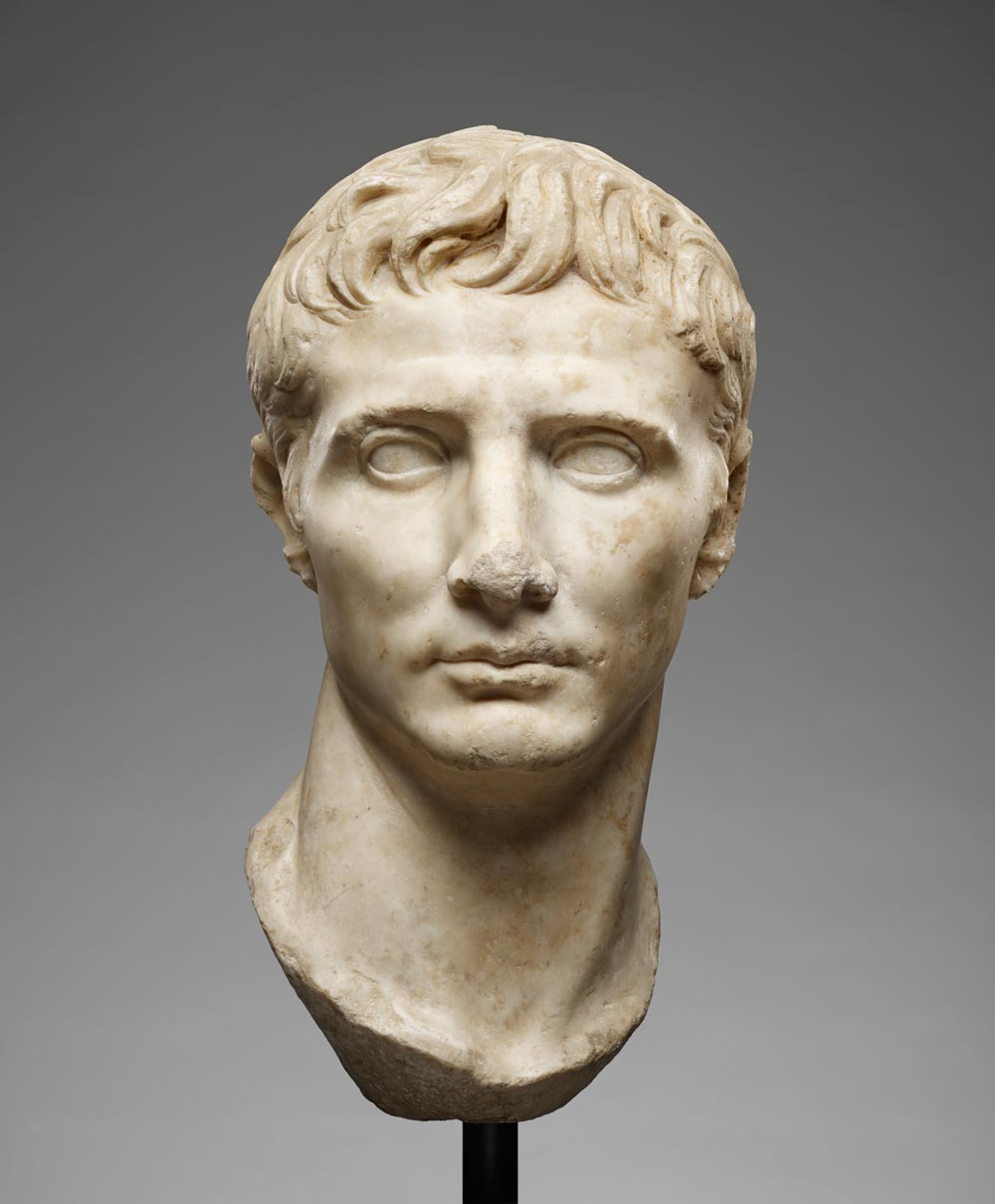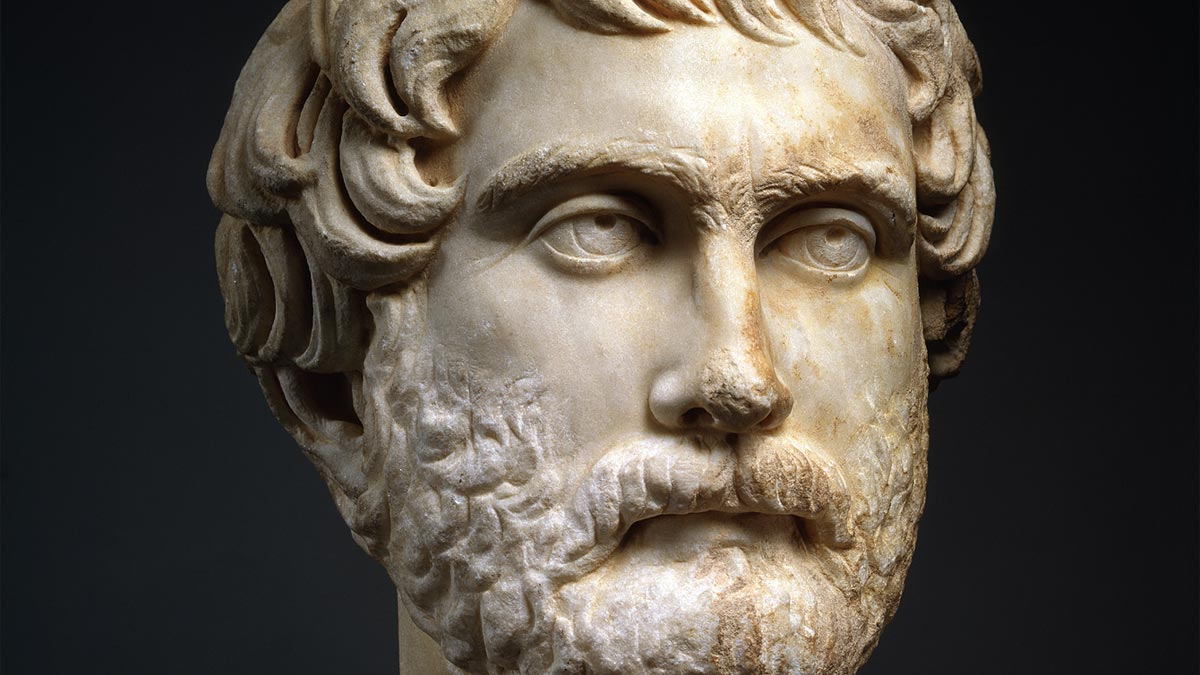Walk into any home today and you’re likely to see photographs of people. Carefully posed family portraits, snapshots from vacation, and, of course, selfies surround us in our homes. People have an almost innate desire to capture the faces of their friends and family, not to mention themselves.
Two thousand years ago, Ancient Romans didn’t have photography, but they did have the same desire to capture and remember the faces of those they loved. Wealthy Roman homes were filled with portraits of family members both past and present, most often in the form of busts and full-length statues. One such portrait, The Milwaukee Art Museum’s Portrait of a Man, was sculpted during the late Hadrianic (117-138 CE) or Antonine Period (138-193 CE). Based on the size and detail of this marble portrait, it would have likely been placed in a prominent position in a house or garden. Just like today, all portraits weren’t created equal, and sculptures like this one are akin to an expensive portrait you might commission from a professional photographer, rather than a snapshot developed at a convenience store.
Roman interest in portraiture was originally based on remembering their ancestors, and a complex culture of ancestor worship thrived amongst all classes of society. Each February the festival of Parentalia (from the Latin parens, meaning parent) was celebrated in honor of ancestors, in which portraits would be paraded through the streets. Portraits eventually became an art for in their own right, and were created in a variety of mediums. Bronze was the most prestigious material used, but also expensive. Marble was also costly, but cheaper than bronze, and was a popular choice for portraits since it was a soft stone easily carve in fine detail. Romans of more modest means still valued portraiture, but utilized materials such as clay instead. Just as people today have family photos of people ranging from infants to adults, Romans commissioned many portraits of themselves throughout their lives. In fact, we have surviving examples from emperors which span their entire lives, from childhood to old age.
You can often tell when a picture of your grandparents was taken based on their clothing and hairstyles, and Roman portraiture is no different. Not only did fashion change, but the way in which portraiture was approached artistically changed over time as well. Portrait of a Man combines styles seen in the Republic and Imperial Periods, which are easily identified if you know what to look for.

Portraiture from the Republic (509-27 BCE) is characterized by the concept of verism (from the Latin veritas, meaning truth), in which all of the minute details and imperfections of the face were depicted. This style is sometimes described as “warts and all,” since no detail, no matter how unflattering, was omitted. Though veristic portraiture is most heavily associated with the late Roman Republic, elements of this style remained popular through the early 3rd century CE. To the Romans, the wrinkles of age (particularly in men) were signs of gravitas (dignity) and auctoritas (authority), and were symbols of experience and nobility. It’s tempting to look at the verismo in Roman portraits and think they are photographically accurate, but veristic portraiture should not be considered a truly authentic representation. Like any other artistic device, verism was consciously used to represent ideas which the Romans found appealing.
Beginning with the reign of Augustus and the coming of the Roman Empire, verism became augmented by classical stylization and idealization inspired by Ancient Greek and Hellenistic sculpture. If you’ve ever seen the cover of a fashion magazine, you’re familiar with this style: though the Romans didn’t have airbrushes and Photoshop, they were adept at idealizing people in their portraits. In portraits of Augustus, for examples, his face is always recognizable, but lacks the “warts and all” emphasis. Portraits in this style often display timeless qualities as well. After becoming emperor, Augustus’ official appearance became static, and he was depicted the same way in his portraits whether they were commissioned at age forty or seventy.
Milwaukee’s Portrait of a Man is indicative of 2nd Century CE portraiture, combining elements of verism and classicism. The man is recognizable as an individual, but his face also displays a degree of “Photoshopping.” Elements found in veristic portraiture are present, such as the slight crow’s feet, wrinkles on the forehead, and prominent unibrow. His eyes, however, with their heavy eyelids, upturned gaze, and accentuated pupils and irises, are typically seen in stylized Antonine portraiture. The shaggy hairstyle and beard both became popular during the Hadrianic Period, and, just like leisure suits and feathered hair in your family photos, can be used to date Roman portraiture. Throughout the Republic and early Empire, elite Roman men always went clean-shaven, and the emperor Hadrian was the first Roman emperor to wear a beard, done in emulation of the Greeks. Emperors were the trend-setters of the day, and as soon as the emperor started wearing a beard, it became fashionable for all men to do so.
The bottom of this portrait is wedge-shaped and loosely worked, demonstrating that it was once part of a full-length statue. While the details of the face were seen as unique and important, stock bodies could be easily reproduced, and it became common for portrait heads to be joined with prefabricated bodies in various poses. Stock bodies for men included nude athletes, military officers, and togati (men wearing a toga). Some of these assemblages appear strange today, with some examples paring an aged head with the nude body of a virile athlete. Think, however, of how derivative our formal photographs are. From Prom to weddings to family portraits, we expect certain conventions to be displayed in our portraits, and the Romans were no different.
—Matthew Rogan, Curatorial Intern



